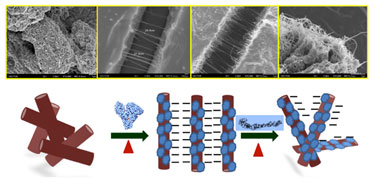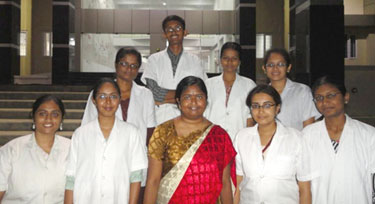Scientists from the Centre for Nanotechnology & Advanced Biomaterials at SASTRA University in India have devised a simple procedure for assembling carbon nanotubes (CNTs) under ambient conditions. The method uses reversible thermal unfolding of BSA bovine serum albumin (BSA) – a protein that is known to adsorb strongly on CNTs and disperses them effectively in water.

Temperature-dependent assembly of BSA-adsorbed carbon nanotubes
BSA has an interesting property of unfolding in a step-wise manner as a function of temperature. The protein remains stable up to a temperature of 40 °C, undergoes reversible changes in conformation from 40–50 °C, followed by irreversible unfolding of α helices and β sheets above 60 and 80 °C, respectively.
To follow the temperature-dependent conformational changes in BSA molecules adsorbed on CNTs, the team used a combination of spectroscopic tools such as infrared and ultraviolet fluorescence spectroscopy.
Heating the mixture
In the study, the researchers found that a random dispersion of CNTs in native BSA at 35 °C is triggered to assemble progressively over the temperature range 40–65 °C, and returns to a random configuration at 80 °C.
Using zeta potential measurements, electron microscopy and binding of sodium cholate, the strong adsorption of BSA on CNT was ascribed to hydrophobic interactions and self-assembly patterns were linked to electrostatic interactions between protein-bound CNTs.

Materials Electrochemistry Group
The work demonstrates that the unfolding pattern of BSA can be used as an ON/OFF switch for CNT assembly under ambient conditions – a concept that could be extended to pattern CNTs on protein-modified substrates for various biomedical, sensing and nanotechnology applications. Also, the connection between the folding/unfolding of a protein and the assembly of nanotubes could lead to the nanotechnology-enabled therapy of diseases related to protein misfolding.
Full details can be found in the journal Nanotechnology.
About the author
The research was conducted mainly by a team functioning under the Centre for Nanotechnology & Advanced Biomaterials (CeNTAB) and extensive electron microscopic investigations were supported by scientists from the Centre for Advanced Research in Indian System of Medicine (CARISM), SASTRA University, Thanjavur, Tamil Nadu, India. CeNTAB is headed by Prof. Swaminathan Sethuraman and financially supported by the Nano Mission Council. CARISM is supported by funding from the Department of AYUSH, Drugs & Pharmaceuticals Research Programme, Department of Science & Technology, India. Nithiyasri Periasamy performed all of these experiments for her dissertation during her graduate programme in medical nanotechnology at CeNTAB and K Balaji, a PhD student of Prof. P Brindha, associate dean, CARISM, helped in electron microscopy. The work was carried out under the guidance of Dr Meera Parthasarathy, principal investigator of the Materials Electrochemistry group at CeNTAB.


